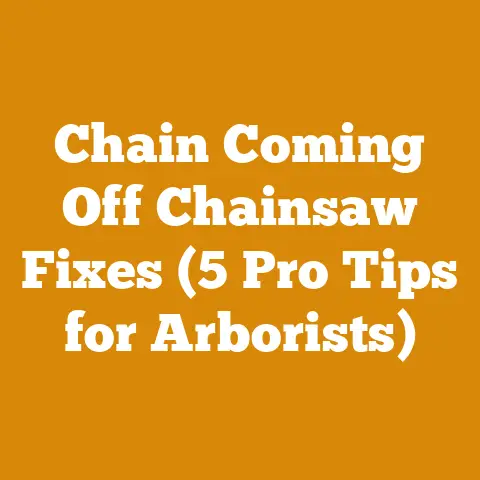Craftsman Chainsaw Fuel Filter Tips (5 Pro Woodcutting Hacks)
Alright, let’s get down to the nitty-gritty of chainsaw maintenance.
Introduction: Busting the “Fuel Filter is Forever” Myth
There’s a common misconception floating around the woodcutting world that once a chainsaw fuel filter is in, it’s good for the life of the saw. Let me tell you, that’s a recipe for a sputtering, underperforming, and ultimately frustrating experience. I’ve seen it too many times – a perfectly good Craftsman chainsaw brought to its knees by a neglected fuel filter. Trust me, ignoring this small but vital component is like trying to run a marathon with a clogged artery. It just won’t work.
In my years of felling trees, splitting logs, and generally wrestling with wood, I’ve learned that a clean fuel filter is the unsung hero of a smooth-running chainsaw. Today, I’m sharing my top 5 pro woodcutting hacks focused on the Craftsman chainsaw fuel filter. These aren’t just random tips; they’re hard-earned lessons from the field, designed to keep your saw roaring and your woodpile growing.
Key Takeaways:
- Fuel Filter Importance: Understand why a clean fuel filter is crucial for chainsaw performance and longevity.
- Regular Inspection: Learn how to inspect your Craftsman chainsaw fuel filter for clogs and damage.
- Proper Replacement: Master the steps for replacing your fuel filter correctly.
- Fuel Quality Matters: Discover how fuel type and storage impact filter life.
- Troubleshooting: Gain insights into diagnosing fuel-related chainsaw issues.
2. The Unsung Hero: Why Your Craftsman Chainsaw Fuel Filter Matters
Let’s face it, the fuel filter isn’t the sexiest part of a chainsaw. It’s not the roaring engine, the gleaming chain, or the satisfying thud of a log splitting in two. But without a properly functioning fuel filter, none of those things happen.
Think of your fuel filter as the gatekeeper to your engine. It’s a small, often overlooked component, usually made of felt, nylon mesh, or sintered bronze, that resides inside your fuel tank. Its sole purpose is to prevent dirt, debris, and contaminants from entering the carburetor and, ultimately, the engine.
Why is this so important?
- Prevents Carburetor Clogs: The carburetor is a delicate piece of machinery with tiny jets and passages. Even small particles of dirt can clog these jets, leading to poor performance, stalling, and difficulty starting.
- Protects the Engine: Abrasive particles can cause wear and tear on engine components like the piston and cylinder, reducing the engine’s lifespan and potentially leading to costly repairs.
- Maintains Optimal Performance: A clean fuel filter ensures a steady flow of fuel to the engine, allowing it to run at its full potential. This translates to more power, smoother operation, and increased cutting efficiency.
- Extends Chainsaw Life: By preventing damage and maintaining optimal performance, a clean fuel filter significantly extends the life of your Craftsman chainsaw.
Data Point: A study by the Equipment Service Association (ESA) found that over 70% of small engine failures are directly related to fuel contamination. This highlights the critical role of the fuel filter in protecting your chainsaw engine.
My Personal Experience: I once spent an entire afternoon wrestling with a chainsaw that refused to start. After checking everything else, I finally pulled out the fuel filter. It was so clogged with debris that it looked like a mud ball. A quick replacement, and the saw roared back to life. Lesson learned: never underestimate the power of a clean fuel filter.
3. Hack #1: The Regular Inspection Routine – Spotting Trouble Before it Starts
Regularly inspecting your fuel filter can help you identify potential problems before they lead to serious performance issues.
Here’s how I do it:
- Safety First: Always disconnect the spark plug wire before performing any maintenance on your chainsaw. This prevents accidental starting.
- Locate the Fuel Filter: The fuel filter is typically located inside the fuel tank, attached to the end of a flexible fuel line.
- Access the Filter: Use a clean hook or bent wire to carefully pull the fuel filter out of the tank. Be gentle to avoid damaging the fuel line.
- Visual Inspection: Examine the filter for signs of clogging, discoloration, or damage. A healthy filter should be relatively clean and free of debris. If it’s coated in gunk or appears torn, it’s time for a replacement.
- The “Shake Test”: Shake the filter near your ear. If you hear rattling, it could indicate that the filter media is breaking down internally, even if it looks okay externally.
- Reinstall Carefully: If the filter appears to be in good condition, carefully reinsert it into the fuel tank. Ensure the fuel line is properly connected and not kinked.
- Frequency: I recommend inspecting your fuel filter every 25 hours of use or at least once a month, whichever comes first. If you’re using your chainsaw frequently or in dusty conditions, you may need to inspect it more often.
Expert Insight: “Regular fuel filter inspections are crucial for maintaining peak chainsaw performance,” says Bob Johnson, a certified small engine mechanic with over 30 years of experience. “A proactive approach can save you time, money, and frustration in the long run.”
4. Hack #2: The Fuel Filter Replacement Masterclass – A Step-by-Step Guide
Replacing a fuel filter is a straightforward task that anyone can do with a few basic tools and a little patience. Here’s my step-by-step guide to ensure a smooth and successful replacement:
What You’ll Need:
- New fuel filter (make sure it’s the correct type for your Craftsman chainsaw model)
- Small pliers or forceps
- Clean work surface
- Gloves (optional, but recommended to keep your hands clean)
- Small hook or bent wire
The Process:
- Safety First: As always, disconnect the spark plug wire before starting.
- Empty the Fuel Tank (Optional): While not strictly necessary, emptying the fuel tank can make the process cleaner and easier.
- Access the Filter: Use the hook or bent wire to carefully pull the old fuel filter out of the tank.
- Disconnect the Old Filter: Use the pliers or forceps to gently disconnect the old fuel filter from the fuel line. Be careful not to damage the fuel line.
- Prepare the New Filter: Attach the new fuel filter to the fuel line. Ensure it’s securely connected.
- Reinstall the Filter: Carefully reinsert the new fuel filter into the fuel tank. Make sure the fuel line is properly connected and not kinked.
- Reconnect the Spark Plug Wire: Reconnect the spark plug wire.
- Test the Chainsaw: Start the chainsaw and let it run for a few minutes to ensure the new fuel filter is working properly.
Important Considerations:
- Correct Filter Type: Always use the correct type of fuel filter for your Craftsman chainsaw model. Using the wrong filter can restrict fuel flow and damage the engine. Consult your owner’s manual or a reputable parts dealer to ensure you’re getting the right filter.
- Fuel Line Condition: While you’re replacing the fuel filter, take a close look at the fuel line. If it’s cracked, brittle, or damaged, replace it as well. A damaged fuel line can leak fuel and create a fire hazard.
- Cleanliness is Key: Keep your work area clean to prevent dirt and debris from entering the fuel tank.
5. Hack #3: Fuel Quality is King – Protecting Your Filter from the Source
The quality of the fuel you use has a direct impact on the lifespan of your fuel filter. Using contaminated or stale fuel can quickly clog the filter and lead to performance problems.
Here’s what I’ve learned about fuel quality:
- Use Fresh Fuel: Gasoline degrades over time, especially when mixed with oil. I recommend using fuel that is no more than 30 days old. If you’re not going to use your chainsaw for an extended period, drain the fuel tank and carburetor.
- Use the Correct Fuel-to-Oil Ratio: Refer to your Craftsman chainsaw owner’s manual for the correct fuel-to-oil ratio. Using the wrong ratio can lead to engine damage and fuel filter clogging.
- Use Fuel Stabilizer: Adding a fuel stabilizer to your fuel can help prevent it from degrading and extend its shelf life. This is especially important if you’re not going to use your chainsaw for an extended period.
- Store Fuel Properly: Store fuel in a clean, airtight container in a cool, dry place. Avoid storing fuel in direct sunlight or near sources of heat.
- Buy Fuel from Reputable Sources: Purchase fuel from reputable gas stations that have high turnover rates. This ensures you’re getting fresh, clean fuel.
- Avoid Ethanol-Blended Fuel: Ethanol can damage small engine components and attract moisture, leading to corrosion and fuel filter clogging. If possible, use ethanol-free fuel. If you must use ethanol-blended fuel, use a fuel stabilizer specifically designed to protect against the harmful effects of ethanol.
Data Point: A study by the Outdoor Power Equipment Institute (OPEI) found that ethanol-blended fuels can cause significant damage to small engines, including fuel filter clogging, carburetor corrosion, and engine failure.
My Personal Story: I once bought a batch of fuel from a gas station that I later discovered had a contaminated fuel tank. Within a few weeks, my chainsaw’s fuel filter was completely clogged, and the engine was running rough. I learned my lesson: always buy fuel from reputable sources.
6. Hack #4: The “Pre-Filter” Shield – Adding Extra Protection
This is a trick I picked up from an old-timer logger. Adding a simple pre-filter can significantly extend the life of your main fuel filter, especially if you’re working in dusty or dirty conditions.
What is a pre-filter?
A pre-filter is simply a piece of coarse filter material, such as foam or nylon mesh, that is placed inside the fuel tank, around the fuel filter. It acts as a first line of defense, trapping larger particles of dirt and debris before they reach the main fuel filter.
How to install a pre-filter:
- Obtain Filter Material: Purchase a sheet of coarse foam or nylon mesh filter material from a hardware store or online retailer.
- Cut to Size: Cut a piece of filter material that is large enough to wrap around your fuel filter.
- Install the Pre-Filter: Carefully wrap the filter material around the fuel filter and secure it with a small zip tie or piece of wire.
- Reinstall the Filter: Reinstall the fuel filter with the pre-filter attached into the fuel tank.
Benefits of using a pre-filter:
- Extends Fuel Filter Life: By trapping larger particles of dirt and debris, the pre-filter reduces the load on the main fuel filter, extending its lifespan.
- Improves Fuel Flow: A cleaner fuel filter allows for better fuel flow, resulting in improved engine performance.
- Reduces Maintenance: By extending the life of the fuel filter, the pre-filter reduces the frequency of maintenance.
7. Hack #5: Troubleshooting Fuel-Related Issues – Diagnosing and Solving Problems
Even with the best maintenance practices, you may still encounter fuel-related problems with your Craftsman chainsaw. Here are some common issues and how to troubleshoot them:
- Chainsaw Won’t Start:
- Possible Causes: Clogged fuel filter, stale fuel, faulty spark plug, clogged carburetor.
- Troubleshooting Steps:
- Check the fuel filter for clogging. Replace if necessary.
- Drain the fuel tank and carburetor and refill with fresh fuel.
- Check the spark plug for spark. Replace if necessary.
- Clean or rebuild the carburetor.
- Chainsaw Starts but Stalls:
- Possible Causes: Clogged fuel filter, clogged carburetor, incorrect carburetor settings.
- Troubleshooting Steps:
- Check the fuel filter for clogging. Replace if necessary.
- Clean or rebuild the carburetor.
- Adjust the carburetor settings according to your owner’s manual.
- Chainsaw Runs Rough:
- Possible Causes: Clogged fuel filter, stale fuel, incorrect fuel-to-oil ratio, faulty spark plug.
- Troubleshooting Steps:
- Check the fuel filter for clogging. Replace if necessary.
- Drain the fuel tank and carburetor and refill with fresh fuel with correct fuel to oil ratio.
- Check the spark plug for spark. Replace if necessary.
- Chainsaw Lacks Power:
- Possible Causes: Clogged fuel filter, clogged air filter, incorrect carburetor settings, dull chain.
- Troubleshooting Steps:
- Check the fuel filter for clogging. Replace if necessary.
- Check the air filter for clogging. Clean or replace if necessary.
- Adjust the carburetor settings according to your owner’s manual.
- Sharpen or replace the chain.
Key Troubleshooting Tip: When diagnosing fuel-related issues, start with the simplest and most common causes first. Check the fuel filter, fuel quality, and spark plug before moving on to more complex issues like carburetor problems.
8. The Craftsman Advantage: Why These Tips Matter for Your Saw
Craftsman chainsaws, while generally reliable, are not immune to the effects of a neglected fuel filter. In fact, their robust design can sometimes mask the symptoms of a clogged filter, leading to long-term damage if left unchecked.
Here’s why these tips are particularly important for Craftsman chainsaw owners:
To keep your Craftsman chainsaw running smoothly for years to come, consider these additional maintenance tips:
- Air Filter Maintenance: Regularly clean or replace the air filter to ensure proper airflow to the engine.
- Chain Sharpening: Keep your chain sharp to improve cutting efficiency and reduce strain on the engine.
- Chain Lubrication: Use the correct type of chain oil and ensure that the chain is properly lubricated to prevent wear and tear.
- Spark Plug Maintenance: Regularly inspect and replace the spark plug to ensure proper ignition.
- Bar Maintenance: Clean and lubricate the bar regularly to prevent wear and tear.
- Proper Storage: Store your chainsaw in a clean, dry place when not in use. Drain the fuel tank and carburetor before storing for extended periods.
10. Conclusion: Fuel Filter Mastery – Your Path to Woodcutting Success
So, there you have it – my top 5 pro woodcutting hacks for Craftsman chainsaw fuel filter maintenance. By following these tips, you can keep your saw running smoothly, extend its lifespan, and tackle any woodcutting task with confidence.
Remember, a clean fuel filter is the unsung hero of a smooth-running chainsaw. Don’t neglect this small but vital component. Inspect it regularly, replace it when necessary, and use high-quality fuel.
Now, go forth and conquer those woodpiles! And remember, a well-maintained chainsaw is a happy chainsaw, and a happy chainsaw means a happy woodcutter.






